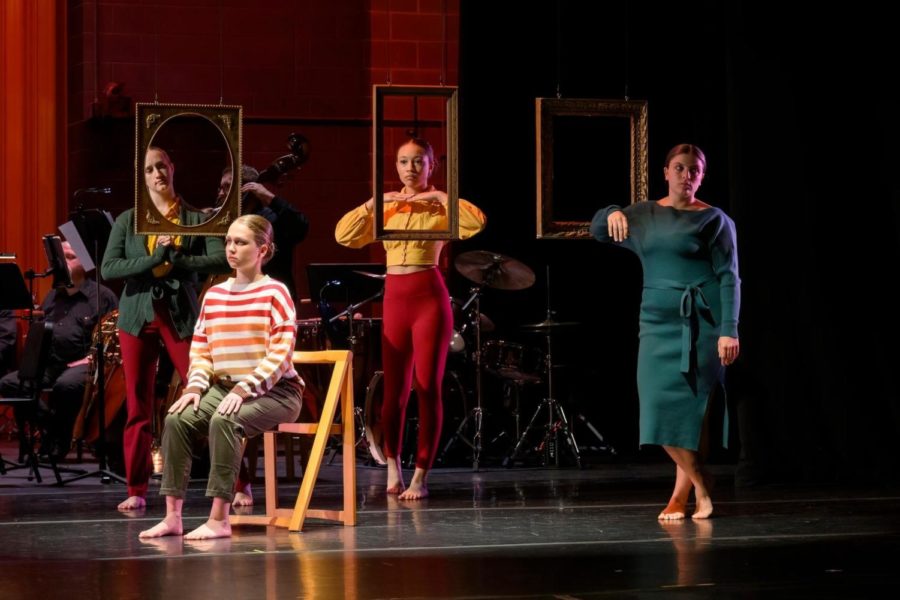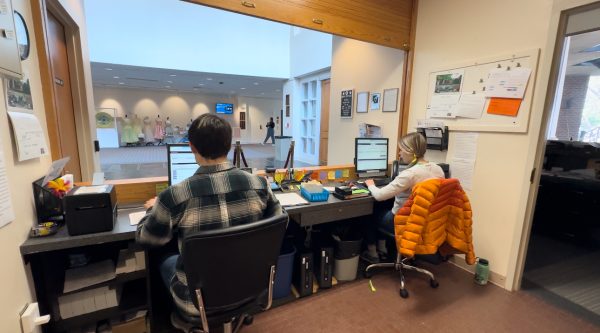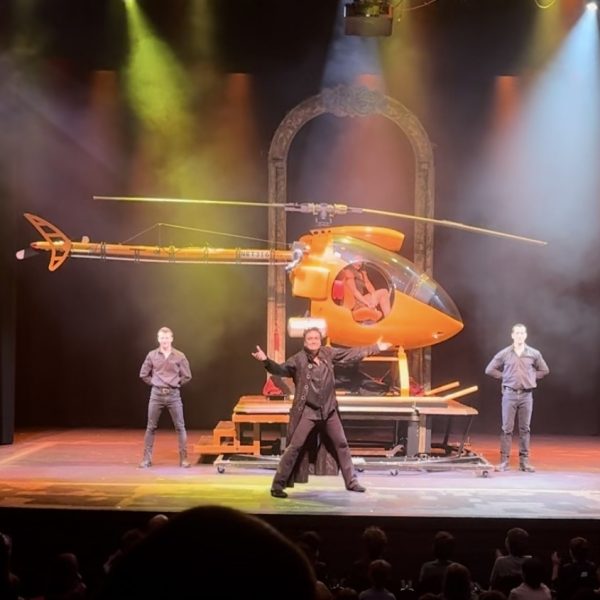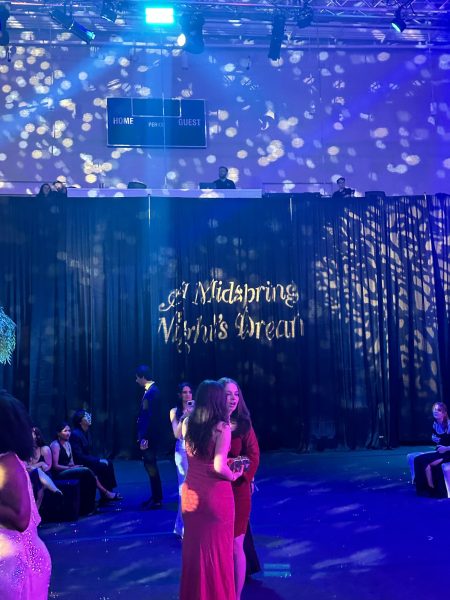W&L Dance Company, Rockbridge Symphony Orchestra celebrate African American artists
Guest artists helped the company tell African American stories through dance and music
Dancers portray tragedies of African American history in the second set. Photo courtesy of the W&L Facebook page
April 11, 2023
The Washington and Lee Repertory Dance Company partnered with the Rockbridge Symphony Orchestra for the first time to put on three performances celebrating the work and histories of African American artists in the week of March 30.
When Jenefer Davies, professor and director of the dance company, began making plans for this year’s winter recital, “helping BIPOC students feel represented” and “broadening students’ education about diversity within art” formed the core of her artistic vision.
At the same time, the Rockbridge Symphony Orchestra under director Yi-Ping Chen was planning a program to highlight the contributions of African American artists, including compositions by Florence Price, Mary Watkins and Duke Ellington.
Davies and Chen began communicating and planning on a collaboration between the two organizations.
“It was really quite serendipitous,” Davies said. “We’ve been looking to feature more live music in our performances, and this coincidence would allow us to unite art forms for a common mission of celebrating BIPOC voices.”
The dance company’s winter recital is always choreographed by guest artists working with Davies, who strives to give students the opportunity to be exposed to dance styles from all over the world. This year, however, Davies invited biracial dance artist Justice Miles to act as temporary dance director and visionary while Davies worked on this year’s Bentley Musical, which “shook up the company’s dynamic,” dancer Angela Tu, ’24, said.
“It was both a rewarding and challenging experience to adapt to the new directorial dynamic,” Tu said. “Justice has a very interesting style of contemporary dancing that incorporates her culture and experiences.”
Miles is known in the dance world for her research into Black influence on the development of flamenco dance, as well as the role race, gender and identity has on choreography. Miles has also had experience teaching and presenting internationally.
While serving as temporary director, she invited African American choreographers Lauren Putty White, Rujeko Dumbutshena and Edgar Page to campus.
White choreographed the first set of the recital, using a musical theater style infused with movements from traditional African dance. When she was choreographing, she told the dancers to imagine that they were strolling through fields and having a picnic with a group of friends.
When the choreography was set to the music of Price’s 1930s “Dances in the Canebrakes” piece, students learned that the composer was telling a tale of slavery, hard labor and the distance between slaves and their mistresses.
“These are two very different stories,” Tu said. “Which can be really difficult. We were wearing these pretty dresses and looked like nineteenth-century housewives, but the music was one of hardship, so this combination is certainly challenging and interesting to wrap your head around. But the main takeaway is that everyone’s history and perspective is different.”
Dumbutshena, a Zimbabwean artist, choreographed the second piece with a modern contemporary style influenced again with African dance. She incorporated props, such as photo frames, to tell a story of celebrating ancestral ties and dealing with generational trauma.
Her choreography was set to contemporary and jazz composer Watkins’ “Soul of Remembrance,” which featured a slow tempo and an expressive, drawn-out melody designed to portray the tragedies of experiences within the African diaspora.
“This second set really grounded the work of this performance,” Davies said. “It was achingly beautiful, and is the piece that spoke the most to me.”
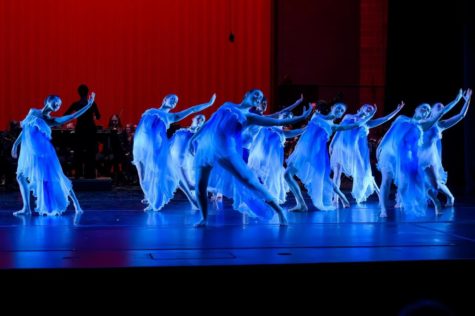
Page, who trained at New York City’s Ailey School, which specializes in world-class diversified dance training, choreographed the last set as a tribute to the water resources and systems that allowed civilizations to thrive.
Set to Ellington’s “The River,” a jazz ballet suite originally composed in 1970 to serve as a metaphor between a river’s progress and the lifespan of humans and societies, Page’s choreography also sought to bind the music to themes of the ocean and water sources in the African American experience.
“Page was my favorite choreographer to work with,” Tu said. “Every time he had a suggestion or comment, he would frame it as offering nourishment. I appreciated each choreographer having their own style and own stories, and showing us their own roots.”
Each artist had three days to work with the dance company, so students had to pick the initial choreography up fast before spending the rest of winter term developing the movements to match each dancer’s vision. Student dancers also didn’t rehearse with the orchestra until ten days before, and only got their costumes the Monday before the first show. But students were able to adapt to these challenges to put on a cohesive show.
Kate Fisher, ’23, president of the dance company, said that over her years as a dancer, she has learned the importance of being adaptable and valuing the team of dancers she gets to make art with.
“I’ve learned to recognize the importance of a cohesive group when you set out to create art,” she said. “I really value my team and their willingness to learn from the guest artists. I love seeing the group grow together to embrace new and unique styles and become stronger.”
She said that as a senior, this last performance was “bittersweet” to her, and that she enjoyed the chance to dance with girls she had spent many hard hours rehearsing with.
Tu, who is also on the executive board of the dance company, agreed that performing with the company allows students to “grow with people you didn’t even realize you could grow with” and that she loves seeing new dancers enter the company every year.
Since 2006, Davies has been in charge of W&L’s dance program, and she hopes to continue working to make dance a welcome and “accessible place for everyone.”
“We have people come in with years of experience, and we have people come in with no experience at all,” she said. “But there’s a place for everyone in dance, and dance company auditions are about finding students’ interests rather than trying to be a barrier to anyone.”
Even if students don’t join as dancers, many members of both the university and Lexington community show up to attend dance recitals and can be exposed to new cultures and artistic diversity by watching the recitals.
“I’m always blown away by how many W&L students show up,” Tu said. “It’s really cool that through dance and through art, we can be storytellers and grow as a community.”



